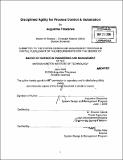Disciplined agility for process control & automation
Author(s)
Tibazarwa, Augustine
DownloadFull printable version (50.63Mb)
Alternative title
Disciplined agility for process control and automation
Other Contributors
System Design and Management Program.
Advisor
Ricardo Valerdi.
Terms of use
Metadata
Show full item recordAbstract
Process automation vendors must consider agility as a basis to gain a competitive edge in innovation. Process Automation systems can impact the operating cost of manufacturing equipment, the safe control of large quantities of energy and the safety of dangerous substances used during manufacturing. The manufacturing segment expects greater automation of larger processes, increased capability of process automation systems, and higher quality of those systems. At the same time, business requirements for process automation vendors demand shorter time to market, and greater market return for each dollar invested in product development. Therefore, process automation vendors must determine how to preserve discipline in development processes while adopting process agility necessary to meet dynamic business conditions. Interviews with 9 leaders from 6 companies (2 manufacturers, 2 process automation vendors and 2 automation consulting firms), survey feedback from development personnel and research of literature on state-of-the-art and state-of-the-practice, yielded over 90 findings and observations on process automation business needs, development of automation offerings, and on suitability of agile practices to process automation product development. Agile methods may require changes to manufacturer work processes, but would enable an automation vendor to unlock more of the manufacturer's production value. (cont.) Disciplined adoption of agile methods is crucial for agility to take hold throughout an automation vendor's organization, and to meet the concerns of process automation stakeholders. Rather than dismiss the suitability of agile development to process automation, a prescriptive guidance is provided that integrates an opportunistic risk-based assessment of how much agility is appropriate. The four values and twelve principles of the Agile Manifesto are a good basis for 8 additional agile practices for process automation: transitioning to agile, investing in agile capability, managing critical system parameters, engineering system-robustness, balancing project risk, continuous system validation, assuring domain expertise and clarifying ecosystem role.
Description
Thesis (S.M.)--Massachusetts Institute of Technology, Engineering Systems Division, System Design and Management Program, 2009. Cataloged from PDF version of thesis. Includes bibliographical references (p. 112-115).
Date issued
2009Department
System Design and Management Program.; Massachusetts Institute of Technology. Engineering Systems DivisionPublisher
Massachusetts Institute of Technology
Keywords
Engineering Systems Division., System Design and Management Program.